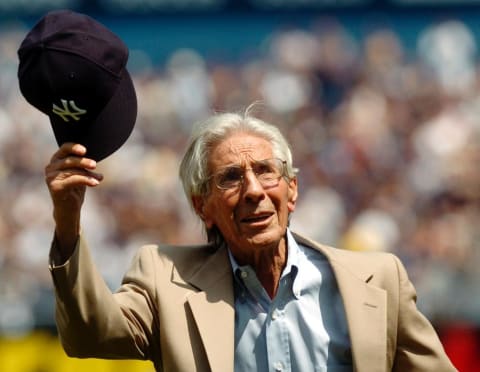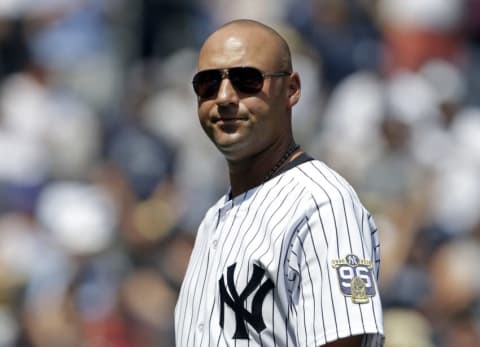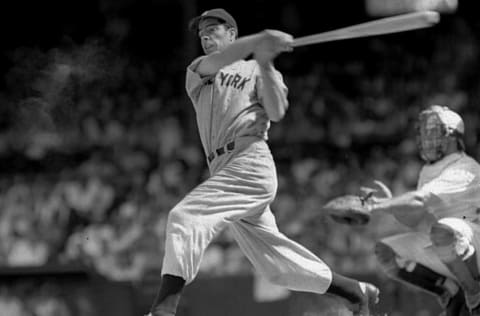Yankees All-Time Greatest Rookie Seasons

Inspired by Gary Sanchez‘s torrid start, Yanks Go Yard ranks the top five greatest seasons by New York Yankees rookies in franchise history.
New York Yankees rookie catcher Gary Sanchez has made some serious noise in the big leagues since his debut August 3rd. The 23-year old set the record for being the fastest major leaguer to reach 11 home runs, was named both American League Player of the Month and Rookie of the Month for August, and should receive strong AL Rookie of the Year support despite missing the first four months of the season.
It’s been 20 years since a Yankees player last took home Rookie of the Year honors, the Captain was the last player to receive the award in 1996 at the start of the dynasty years. This recent drought is an anomaly in the team’s history, however, as the Bombers have had eight Rookie of the Year winners since the inception of the award in 1947.
The following is a highly subjective list of what one writer considers the best debut seasons in New York Yankees history. But first, here are the honorable mentions of the guys who couldn’t quite crack the list:
Willie Randolph: According to Baseball-Reference’s wins above replacement metric, Willie netted five WAR in 1976, the second most among any Yankees rookie position player in history. The problem in my eyes is that almost all of that value came on defense. He only hit .267/.356/.328 that year, and I’m not sure I trust our evaluations of defense in 1971 to put Willie on this list.
Russ Ford: The 27-year-old pitcher actually has the highest WAR of any Yankees rookie ever with 11. He managed the feat by throwing 299.2 innings in 1910 however. Was he a great pitcher? Probably. But the game was so different back then that I just can’t consider him a serious candidate.
Stan Bahnsen: The 1968 American League Rookie of the Year has undeniably impressive numbers– 2.05 ERA and 2.64 FIP in 267.1 IP– but they need to be taken with a grain of salt because they came in the infamous “Year of the Pitcher.” In my view that’s just enough to keep him off the list.
Gil McDougald: This often-overlooked Yankee Great comes just shy of reaching the pantheon once again. He took home ROY honors in 1951 by hitting .306/.396/.488 with 14 homers while playing splitting his time between second and third base. It was an excellent year, but just didn’t have the resonating impact of some of the players on this list.
Next: Scooter

Phil Rizzuto
While his 1941 debut season was largely overshadowed by Joltin’ Joe’s hitting streak, Phil Rizzuto had a superb year in his own right during his rookie year. The man affectionately known as Scooter hit .307/.348/.398 (96 OPS+) while playing an excellent shortstop.
Taking over everyday duties at short from the declining Frankie Crosetti, Rizzuto was half of an outstanding middle-infield combo for the team with Joe Gordon. Both future Hall of Famers received MVP votes that year and were an enormous part of the club’s success. The Rookie of the Year award wasn’t implemented until six years later, but Scooter would have been the likely front-runner had it existed.
Scooter was an important contributor to the club’s 12th American League pennant, helping New York to a 101-53 record, 17 games ahead of the second place Boston Red Sox. As with most years at the time, the Yankees faced off against the Brooklyn Dodgers in the 1941 World Series.
The rookie shortstop didn’t add much with the bat during the series, going 2-for-18 with three walks and a stolen base. Still, the lineup was so loaded this year that it could absorb a slump from any of its best hitters. New York cruised to their fifth title in six years and ninth overall to that point.
Rizzuto of course would go on to play his entire 13 years in pinstripes, making five All-Star teams, taking home AL MVP honors in 1950, and collecting an incredible eight World Series rings.
Next: The Captain

Derek Jeter
This is where personal bias comes into play. Jeter’s numbers may not stack up with some of the guys left off this list, but his emergence as the face of the Yankees in 1996 kicked off one of the most dominant dynasties in the history of sports and restored New York to its rightful place as perennial contenders after the dark ages of the 1980’s and early 90’s.
The 22-year-old Captain-in-Training hit .314/.370/.430 with 10 homers and 14 stolen bases and filling the Yankees long-time hole at short. He was only the fifth unanimous choice for Rookie of the Year in the award’s history.
Yankees manager Joe Torre demonstrated his faith in his rookie shortstop by hitting him leadoff during the 1996 postseason, despite beginning the year batting ninth. Jeter got right to work building his reputation as one of the most clutch performers in history, going 22-for-61 across three playoff series that year.
Jeter’s first career postseason home run famously received an assist from 12-year-old fan Jeffrey Maier, who reached into play and caught the ball, tying game one of the American League Championship Series at four and setting up an eventual New York win.
With many of the team’s regulars struggling, Jeter provided a spark at the top of the lineup that would prove crucial to winning the organization’s 23rd World Series championship over the Atlanta Braves that year. It was their first title since 1978, and Jeter, of course, would go on to lead the Yankees to another four championships before he was through.
Next: Gator

Ron Guidry
Although he had received brief cameos with the big league club the previous two seasons, Louisiana Lightning didn’t really make a name for himself until 1977, when he emerged as one of the most dominant pitchers in Yankees history. Ron Guidry led the league with a 2.73 FIP over 210.2 innings of work that year, pitching to a 2.82 ERA and racking up 176 strikeouts.
Guidry’s incredible performance tend to be overlooked somewhat because the loud conflicts between Reggie Jackson, Billy Martin, and George Steinbrenner tend to dominate the discussion of the 1977 season and the “Bronx Zoo” era as a whole, but it’s hard to overstate how important Gator was to that club’s success.
In his first full season, the 26-year-old Guidry received both Cy Young and MVP votes. As amazing as he was, his 1977 campaign was really just a warm up for his career-year the next season, when he led the league in ERA (1.74), FIP (2.19), WHIP (0.946), ERA+ (208), Wins (25), and winning percentage (.893) in route to the AL CY and a runner-up finish in the MVP voting.
The Yankees were undefeated during the rookie’s three postseason starts. Overall, he allowed just seven earned runs in 20.1 IP, striking out 15 batters and walking six, leading New York to their first World Series championship since 1962.
Next: The Yankee Clipper

Joe DiMaggio
The Yankees got a pretty decent return on the $8,500 salary they paid the rookie Joe DiMaggio. The 21-year-old future Hall of Famer hit .323/..352/.576 (128 OPS+) during his first taste of the big leagues while making his first of 13 All-Star squads and leading the league in triples.
It only took DiMaggio 138 games to collect a career-high 206 hits during his debut campaign. He also collected 29 home runs, 125 RBI, and 132 runs scored. Amazingly, the 39 times he struck out in 669 plate appearances that season (5.8% K rate!) was the highest total of his career.
The Yankee Clipper finished eighth in the 1936 MVP voting, beginning a streak of seven top-ten MVP finishes.
Joltin’ Joe led the good guys to their eighth American League pennant and fifth World Series title that year. He went 9-for-26 with three runs and three RBI as the Yankees took home the championship in six games over the New York Giants.
DiMaggio went on to be one of the most revered players in baseball history, making the All-Star team in every year he played, enjoying the longest hitting streak in MLB history at 56, and landing in the Hall of Fame in 1955.
Next: Tugboat

Thurman Munson
Selected with the fourth overall pick in the 1968 draft, Thurman Munson played in just one full minor league season before taking over the Yankees starting catcher job in August of 1969. With just 87 at-bats that year, Munson snuck in right under the bar to keep his rookie eligibility another season.
“The Walrus” broke out with one of the best seasons by a Yankees backstop in history in 1970, batting .302/.386/.415 (126 OPS+) in 526 plate appearances and 125 games behind the plate. With 5.5 wins above replacement according to Baseball-Reference’s metric, Munson had the most valuable rookie season of any position player in Yankees history.
At 23-years-old, Munson took home the American League Rookie of the Year award for the season and finished 19th in the AL MVP voting. The Yankees went 93-69 that season, their best record since 1964. The pieces that would lead to back-to-back World Series championships later in the decade were beginning to fall into place.
Next: Severino Following Same Path as Betances
In 1976, Munson was selected as the first Yankees captain since Lou Gerhig’s retirement in 1939. He played 11 seasons in pinstripes, making seven All-Star squads, three Gold Glove awards, and the 1976 MVP before his untimely death in 1979.